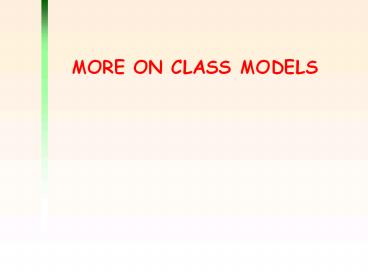MORE ON CLASS MODELS - PowerPoint PPT Presentation
Title: MORE ON CLASS MODELS
1
MORE ON CLASS MODELS
2
Outline
- Aggregation and composition
- Roles
- Navigability
- Qualified association
- Derived association
- Constraints
- Association classes
3
Aggregation and composition
- Aggregation and composition are kinds of
association - Instead of just showing that two classes are
associated we may choose to show more about what
kind of association this is - Aggregation and composition are both ways of
recording that an object of one class - is part of
- an object of another class.
4
Module is a part of an HonoursCourse
- The notation with open diamond, denotes
aggregation, which is more general way of
denoting a part-whole relationship in UML
5
- Aggregation is essentially a conceptual notion
- seeing an aggregation in a class model should
help you to understand the relationships between
the classes at an informal level - BUT does not give you any more formal information
about how they must be implemented or what you
can do with them
6
Composition
- Composition is a special kind of aggregation
which does impose some further restrictions. - In composition association, the whole strongly
owns its parts - If the whole object is copied or deleted, its
parts are copied or deleted with it - The multiplicity at the whole end of a
composition association must be 1 or 0..1 - A part cannot be part of more than one whole by
composition
7
ExampleNoughts and Crosses(Tic-Tac-Toe)
- Composition is shown just as aggregation is,
except that diamond is filled in
8
Roles
- Often you can read an association name in both
directions (is taking,is taken by) - Sometimes, however, it is more readable to have
separate names for the roles that the objects
play in the association.
9
Association with no navigability
- The diagram records that
- For each object of class Student there are six
objects of class Module which are associated with
the Student - For each object of class Module there are some
Student objects (the number of students is
unspecified) associated with the Module.
10
Navigability
- We can put an arrow on one or both ends of the
association line to represent that it is possible
for messages to be sent in the direction of the
arrow - We say that Module knows about Student, but not
vice versa.
11
Qualified associations
- Occasionally it is helpful to give finer detail
about an association than we have so far.
- Square is identified relative to the board its
on by attributes raw and column, each taking a
value between 1 and 3
12
Qualified composition
- In fact we can combine the qualified association
notation with the other adornments on
associations - For example, we can add back the information that
this particular association is a composition
13
Derived associations
- Derived association exists automatically once we
have implemented the main association - A derived association as shown using a slash in
front of its name - The black triangles indicate which direction of
the association the name describes.
14
Constraints
- A constraint is a condition that has to be
satisfied by any correct implementation of a
design - The formal constrains can be written in OCL, the
Object Constraint Language (developed by IBM) - OCL is intended to be
- Formal, so that constraints written in it are
unambiguous - Easy to use, so that every developer can write
constraints in it
15
- The xor constraint is not written in OCL, its a
special predefined constraint which is part of
UML
Each copy object represents either a copy of Book
or a copy of Journal
16
Association classes
- Thing which is both an association and a class,
which is unsurprisingly called an association
class
17
Avoiding an association class































